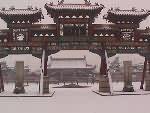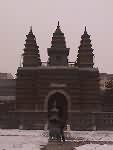- Getting around Lijiang. Dont stay in the Old Towns more than 2 days, there is nothing to do. KRISS Oct 9, 2013 05:46
- 2013 Beijing Temple Fair BENNYLAU Feb 26, 2013 03:29
- Malaysian traveling from KUL - LAX vis Shanghai PVG ZATI_DY Jan 3, 2013 20:15
Regal In Winter Reds
- Views: 5707
- |Vote: 1 0
- |Add to Favorites
- |Recommend to Friends
Mongolia in Winter Snows
Who would choose to go to Mongolia in winter? Both the Inner Mongolian province within Chinese territory and the independent Republic of Mongolia have the reputation amongst travellers as being some of the most remote and featureless territories on Earth. There is some interest in the warmer seasons, when Mongolia is coated in lush green grasslands, and visitors can enjoy long, open days with nomadic locals, who pass their time making milk cheese tea and dancing for tourists, and quiet nights under countless stars in a clear sky. But under the winter snows, Mongolia is an endless plain of Antarctic white stretching for miles in all directions, pretty and pointless.
Of course, there is something to be said for an empty paradise of virgin snow, and in the cities, isolated in the middle of it all, there is a strong sense of seclusion and resilience against the harsh winter climate. It's almost Christmassy, the lights and crimson boards and warm black sooty homes are decorations in a waxen-white realm.
Amongst these strongholds in the wilderness, Huhehaote (known to the world as Hohhot) is the capital of Chinese Mongolia and the centre of development for the whole Autonomous Region of Inner Mongolia. Its history doesn't go back very far – it was originally a centre for Lamaist Tibetan Buddhism (which has been a dominant religion in Mongolia ever since the days of Kublai Khan) about 400 years ago when it was established under the name Kuku-khoto, which simply means 'Blue City'. After it was inundated with Han Chinese farmers, seeking to build new lives by farming the rich soil and thus escape from the overpopulated southern provinces, it was given a Chinese identity under the name Guihua. About a hundred years later, another city was built nearby called Suiyuan, and when the two joined together as one major trading town, it was relabelled Guisui, and then Huhehaote.
Huhehaote gained the status it enjoys today as the capital of the province only after a period of very complicated border reshuffling. The borders of Inner Mongolia have been reorganised so frequently that some cities have switched provincial allegiances three or four times in the last fifty years. In an attempt to maintain political stability in a sensitive border region - an administrative reservation for the concerns of the Mongolian ethnic minority who make up only a fraction of the vast region's population - parts of the province have been switched over to Heilongjiang, Jilin, Liaoning, and Hebei, only to be returned later on and sometimes taken away again. The former capital, Zhangjiakou, is now a relatively insignificant town in Western Hebei.
In winter, Huhehaote seems to undergo a mild hibernation. Already a low-key city of only token modernisation, during the long cold months, the roads are almost empty. A few cars make their hesitant way along the icy tarseal under the shadow of grey cloud, and the locals seem hesitant to leave the bosom of their coal-heated family rooms. Perhaps for this reason, it's a great place to visit even out of the regular tourist 'yurt-homestay' season, when tourist groups usually come for the chance to live in a traditional tent-style home with local Mongolians. Wrap up warm and mooch around the lonely streets – Hohhot rewards winter wanderers with the kind of peace of heart that perhaps accords in spirit with the inner stillness of Tibet.
The Tibetan Temples
Because of its religious connections with Tibetan Lamaism, the sites of most interest for visitors to Huhehaote are the unusual temples scattered around the city. Most of the most noteworthy temples are in Yuquan Qu in the Southwest of the city – an area also convenient to the Great Mosque in the city's Muslim district.
I arrived on a very early morning train into Hohhot, and made my way directly to the temple area. Hohhot was under the snow far longer than other cities in Xibei – the Chinese Northwest – and even though most Northern cities were relatively warm and dry, Hohhot was awakening from another night's fresh snowfall. In the morning light, the city was a pale blue, and I fancied that I could understand why the city had once been known as the 'blue city'. A few lone, darkly dressed men were cycling through the just-swept streets as traffic lights shifted colours across the snow-caked tree branches like hanging Christmas bulbs.
I took a taxi to the street where the local map told me most of the temples were to be found. It was still early, and I was hoping to get some traditional Chinese food for breakfast from a roadside stall, but couldn't find any at all, and was forced to resort to the enterprising, early-opening KFC. A hot coffee and nasty burger later, I was walking through Hohhot's bleak snowy streets the wrong way and slightly lost. I passed a number of instrument stores, steel garage door fronts rolled up to the top, and stared curiously at the piles and piles of red, leather-skin drums, brilliant against the whitish glare of morning like great clusters of toffee apples. They seemed to fit in with the colour scheme of the temples themselves, when I found them, rich regal-red walls like palaces in the snow.
I first snuck inside the Xilituzhao Temple through an open side door on Stone Lane. It was actually closed, and the monks looked as if they were just getting up, although they'd probably been at prayer since 5 a.m. A few of them looked at me oddly as I wandered through the temple's main courtyard, which was overhung with row upon row of brightly coloured Tibetan prayer flags, a semaphore of incantations. I wasn't really supposed to be there, and so I made a quick exit, but I was quite grateful to have had the chance to see the inside of the temple 'off-guard' and without any other tourists around. It's a lovely place, and at 430 years old remains the largest Lamaist religious centre in the city – and has been the home of the 'Living Buddha', currently in His 11th incarnation, since 1735.
A short walk away is the Dazhao 'Yellow Hat' sectarian temple, which I wasn't lucky enough to catch with a side door open – a shame as I was hoping to see the great Silver Sakyamuni Buddha inside, a representation of the Buddha particularly sacred to Tibetan Buddhism. This particular posture of the Buddha represents the moment of enlightenment – Sakyamuni sits with one hand touching the Earth to symbolise his oneness with the world. I hung around the entrance for a while beneath the great wooden gate, placed in the yard before the temple and crested with Chinese and Qing Dynasty Manchu characters, before submitting to the cold and walking away for the Great Mosque.
The Rest of the Temple Circuit
The mosque was a great surprise. It was very difficult to place the influences on the decorations of the mosque exterior, which seemed to draw on Chinese art as much as Middle Eastern. The front reminded me of a train station or town hall, with a grand clock fixed above the doors. A great minaret, in the same grey and green colour scheme of the main body of the mosque, was curiously roofed like a pagoda, with the crescent moon positioned on its spire. It was now open for worship, and a few white-capped Hui Muslim men where gathering outside. Not being a member of the faith, I wasn't allowed inside, but was able to wander through the grounds peacefully enough.
I took another taxi to the fourth and cutest site of the Hohhot temple circuit – the Five Tower temple on Gongyuan Xi Lu. The photos exaggerate the size of this stumpy building, which is only 16 metres tall, but its size makes it quite endearing. I paid the entrance ticket of just ten yuan and climbed the short staircase to the top floor, stopping momentarily to appreciate a Mongolian planisphere – the only one of its kind – which accurately marks the locations of hundreds of stars. The relief sculpture is fascinating, being the only record of an advanced astronomical science in Ancient Mongolia. On top of the temple, I walked all around the five individual Indian-style towers, all tiled with individually sculpted Buddhas, as are the walls of the temple proper – 1563 in total. The Ci Deng Temple that it was once part of no longer remains, and from the top all that is visible is an enormous plain of small brick houses, smoking out their coal like old men's pipes.
I spent much of the rest of the morning in Qingcheng Park, the city's largest park reserve. In the summer weather, it must be a very pleasant, but otherwise ordinary, Chinese park with lakes, little bridges and amusement rides. Winter is better: the water is frozen solid and caked with snow, the bare trees lining the pathways all with snowflakes squeezed along their boughs like toothpaste. Local Hohhotese wrap up and make snowmen: it was the only place where I saw a significant number of locals in the cold weather.
I came to the rather obvious conclusion that there's no reason not to include this city in a winter itinerary at all – Hohhot is a quiet, lovely place under the snow, and the blush of red temple wall that stands out in the snow is like a small, divine window into the Himalayas.






 Copyright © 1998-2025 All rights reserved.
Copyright © 1998-2025 All rights reserved.
1.
Nov 8, 2016 23:55 Reply
Mr.CHIA from Malaysia said:
Awesome article from a travellers point of view. Beautifully written. Enjoyed it. Glad I found this article. I knew it wasn't a bad idea to go to Hohhot in winter. Saw lots of beautiful winter pictures but nobody really talked about it. Thanks to you now.
2.
Dec 11, 2005 05:23 Reply
LEMONCACTUS said:
This is a great little piece. I was wondering whether to hop over to Inner Mongolia this winter, but couldn't see the point.
However, I love snow and a lack of tourists. It sounds perfect. Thanks for the insights.
Feb 5, 2012 15:27
Ms.LIUDA from Russia replied:
Hi, I really liked reading this review! I would say quite a poetic description! I'm going to be in Hohhot half a year from now on... and my friends who were there kept discouraging me, but your review cheered me up, thanks!=)